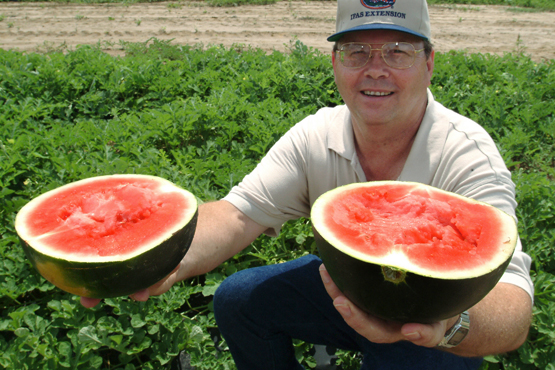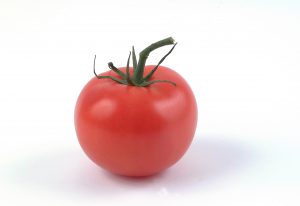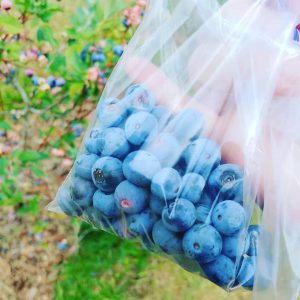
by Dorothy C. Lee | Aug 4, 2020
The taste and fragrance of a cool, juicy slice of fresh melon in the summer just can’t be beat. Melons have been a favorite fruit for many centuries. They appear in Egyptian tomb paintings dated to 2400 B.C., and they are mentioned in the writings of the early Greeks and Romans. Mark Twain called watermelon “the food that angels eat.”
Uses & Preparation
Watermelon, honeydew, and cantaloupe are excellent cut up in salads, as a dessert, or alone as a cool, refreshing snack anytime. To save space and cooling time in the refrigerator, cut up the melon and cover tightly with plastic wrap.

UF/IFAS Photo
Selection
Thumping watermelon to judge ripeness is not always accurate, because you can’t tell if it is ripe or overripe. Instead, look for a well-proportioned melon with full ends, a dull outer skin, and the bottom a yellowish color, or turning from white to pale green.
Cantaloupe should have no sign of a stem, be nicely rounded, and the netting should be evenly distributed. Golden-colored melons with a mild melon odor are the peak of ripeness, while green ones will ripen in a few days if kept at room temperature.
A ripe honeydew melon has a creamy yellow rind that is soft and velvety. The best – tasting honeydew smells slightly fruity. Hold a honeydew at room temperature for a few days for even tastier fruit.
Melon Salad
Arrange balls or slices of watermelon, cantaloupe, or honeydew melon, alone or in combination, on lettuce. Serve with French dressing. Diced apples, diced pears, nuts, and chopped celery may be added for variety.
Chicken & Watermelon Salad
5 chicken breast, boned, skinned, cooked and cubed
3 cups watermelon, cubed
3 cups pears, cored and cubed
1/2 pound sliced mushrooms
1/2 pint low-calorie Italian dressing
Combine all ingredients, toss gently. Refrigerate on hour, stirring occasionally. Serve on a bed of lettuce.
Nutrition Information
Low in sodium. Low in calories. Good source of vitamin A.
Available Fresh
June – August
To learn about fresh Florida melons, please read our fact sheet: Panhandle Produce Pointers – Melons
For more delicious produce preparation tips, please visit: http://www.panhandleproducepointers.com.

by Dorothy C. Lee | Jun 11, 2020
The classic succulent vegetable of summer is ripe for your salads, sandwiches and salsa. Tomatoes can be used many ways to make good food with good nutrition.

Tomatoes are one of the most popular vegetables among home gardeners. Excellent source of vitamins C and A. (Photo source: UF/IFAS file photo)
Uses & Preparation
Unripe tomatoes take 3 to 4 days to ripen. Use ripe tomatoes within a day or two. For best flavor, do not refrigerate. Slice, wedge or dice; sprinkle with a fresh herb, drizzle with olive oil and serve. Wonderful with slices of avocado, but then skip the olive oil. Stuff with seafood, chicken, or pasta salad. Cherry tomatoes make a delicious, nutritious snack by themselves.
Selection
Ripe tomatoes will give slightly to gentle pressure.
Storage
Store unwashed at room temperature and out of direct sunlight.
Tomato, Zucchini & Onion
2 cups sliced tomato
2 cups sliced zucchini
2 cups sliced onion
1 1/2 teaspoon Italian herb seasoning
1/2 teaspoon salt (optional)
dash of pepper
Preheat oven to 350 degrees. Layer onion, tomato, and zucchini in a 2-quart casserole dish that has been sprayed with a non-stick coating. Sprinkle each layer with seasonings. Bake for 30-45 minutes, depending on how soft you want the vegetables.
Basil Tomatoes
The addition of basil gives an excellent flavor to fresh tomatoes.
2 cups tomatoes, diced or sliced
1 teaspoon dried basil
1 teaspoon chopped garlic
1/2 teaspoon salt (optional)
1/8 teaspoon pepper
Mix ingredient and let sit at room temperature at least 1 hour. Serve plain or on a lettuce leaf.
Nutrition Information
Excellent source of vitamin C. Good source of vitamin A.
Available Fresh
June – July & September – October
To learn about fresh Florida tomatoes, please read our fact sheet: Panhandle Produce Pointers – Tomatoes
For more delicious produce preparation tips, please visit: http://www.panhandleproducepointers.com.
For a quick and easy salsa, please visit: Easy Salsa
UF/IFAS Extension is an Equal Opportunity Institution.

by Dorothy C. Lee | Mar 26, 2020

Strawberries from Fresh off the Farm event. Taken 04-12-2019 (Photo Source: UF/IFAS Camila Guillen)
Choose locally- grown strawberries during the harvesting season; they will be the freshest and the most flavorful. When picking strawberries, try to pick early in the morning or later in the day when the fruit is cool. Strawberries are best used within 2-3 days of picking.
Uses & Preparation
Freezing Whole Strawberries; Spread a single layer of prepared fruit on shallow trays and freeze. When frozen, promptly package (to avoid freezer burn) and return to freezer. The fruit pieces remain loose and can be used as needed.
Freezing Sliced or Crushed Strawberries; Prepare berries: Using ripe berries, wash gently and remove caps. Slice or crush partially or completely. To 1 quart berries add 3/4 cup sugar. Mix thoroughly. Stir until most of the sugar is dissolved or let stand 15 minutes. Pack into containers, leaving 1/2″ headspace. Seal and freeze.
Storage
Sort and remove any bruised or damaged berries as soon as possible and use in sauces, purees or jams. Place the berries in cool, well-ventilated containers. The moisture content of fresh strawberries is high, so store them unwashed and uncovered, or loosely covered.
Quantities
1 pint = about 3 1/4 cups whole berries (12-36 depending on size of berries) or about 2 1/4 cups sliced berries. 1 cup sliced fresh berries = One 10-oz. pkg frozen, sweetened berries.
MERRY FRESH STRAWBERRY PIE
1 9- inch pie crust, baked
1 cup white sugar
3 tablespoons strawberry flavored gelatin mix
2 tablespoons cornstarch
¼ teaspoon salt
1cup boiling water
2 pints strawberries, cleaned and stemmed
2 cups whipped topping (optional)
Combine sugar, gelatin, cornstarch, and salt in a medium saucepan. Stir in boiling water. Boil mixture for 3 minutes over high heat, stirring constantly. Cool completely.
Arrange whole strawberries in pastry shell. Pour gelatin mixture over berries. Chill before serving. Top with whipped topping, if desired.
Nutrition Information: Low in calories – High in Vitamin C – Good source of folate, potassium & fiber
Available Fresh: April – May
To learn about fresh Florida strawberries, please read our fact sheet: Panhandle Produce Pointers – Strawberries.
.For more delicious produce preparation tips, please visit: http://www.panhandleproducepointers.com.

by Stephanie Herzog | Jul 25, 2019

Eating fresh, local produce is a great way to be healthier, save money, and support the local economy. (Photo source: Stephanie Herzog)
Summer Local Eats – Supporting Farmers’ Markets
Summer is a great time of year to eat locally grown fresh produce! There are many options rich in a variety of colors, shapes, sizes, and nutrients. Farmers work hard to provide life-sustaining sustenance for society, and consumers supporting their efforts at the local level has an array of health and economic benefits.
Fresh summer crops in the panhandle abound. Produce that is ready this time of year includes peppers, cucumber, peanuts, okra, squash, corn, and watermelon. Spice up a summer salad with fresh cucumbers or peppers or try tasty yellow meat watermelon for a chill and nutritious summertime snack! Local, fresh produce is a healthy alternative to processed foods or produce found in grocery stores. Produce sold by local farmers is freshly picked and because you know where it comes from, it is both safer to eat and keeps for longer periods of time than grocery store produce, which often has traveled long distances, is seldom inspected, and is kept in storage before finally being put out on the floor for purchase.
Supporting your farmers’ market benefits both you and your community in many ways. Purchasing from local farmers and farmers’ markets is both financially sound for you and is supportive of the community’s economy – the money changes hands locally and creates and maintains jobs. Not only does it benefit the economy, it also fosters a stronger sense of community unity and trusted relationships, which is vital to any successful society and local economy. For example, farmers will sometimes offer a “u-pick” program, depending on the crop, where you go to their farm and pick what produce you want right from the field! You get to keep half, and the farmer keeps half. This is a great cooperative effort that benefits everyone – you get free, fresh produce, and the farmer gets free labor. Who doesn’t love a win-win scenario?
Jackson County farmers’ markets information. Residents in Jackson County have a wonderful farmers’ market in the heart of downtown Marianna, located at Madison Street Park (2881 Madison St.) that goes throughout the summer every Tuesday, Thursday, and Saturday morning from 7am-12pm. After September, the market will continue through the fall, winter, and spring each Saturday at the same time. Tuesday and Thursday have farmer vendors only, while Saturday includes a variety of vendors, such as arts and crafts, plants and flowers, jams, jellies, honey, etc. This market also offers a raffle when you purchase items from vendors! For any questions about the market or how to join as a vendor, visit their Facebook page or contact Tony Mayo, the current farmers’ market manager or Terry Johnson, the public relations manager for the market. His number is 850-592-5114. It’s a good idea to bring cash or checks, but some vendors do accept credit and debit cards.
Want to find a farmers’ market near you or learn more about the benefits and best practices shopping at a farmers’ market?
Come experience the buzz and benefits of the farmers’ market!
Sources:
Local farmers at the Marianna City Farmers’ Market
Wang, Q., Evans, E. A., Pikarsky, M., & Olczyk, T. Consuming local vegetables from our local growers. UF IFAS publication HS1251.

by Amy Mullins, PhD, RDN | Apr 26, 2018

photo credit: Amy Mullins, UF IFAS Leon County Extension
Have you ever imagined planting a small garden and growing vegetables for your family? It may seem like a difficult and daunting project, but I assure you the benefits of growing your own vegetables far outweigh the reservations and roadblocks that may have previously stood in your way. Among these benefits include increased physical activity, stress relief, better mental health, and better nutrition. Consuming a diet rich in produce can reduce overall calorie consumption and provide a variety of nutrients to minimize the risk of developing chronic diseases associated with overweight and obesity.
Growing your own vegetables and herbs in the best way to “eat locally”! The convenience of having what you need for fresh salads, soups, and sides right outside your door can enable you and your family to have a healthier diet. And did you know that when children are involved in the gardening process, they are actually more likely to increase their consumption of fruits and vegetables? Pull the kids off the couch and get whole family involved in garden planning, planting, maintaining, harvesting, and cooking.
Spring is the time to plant beans, cucumbers, eggplant, melons, okra, field peas, peppers, summer and winter squash, sweet potatoes, and tomatoes. Just think of all the possibilities for an abundance of healthy eating this summer!
Getting started is easy. Check out these UF IFAS resources to help get you on the right path to growing your own produce:
Edible Landscaping
Florida Vegetable Gardening Guide
Plant These Spring Herbs
Produce Pointers Recipes










